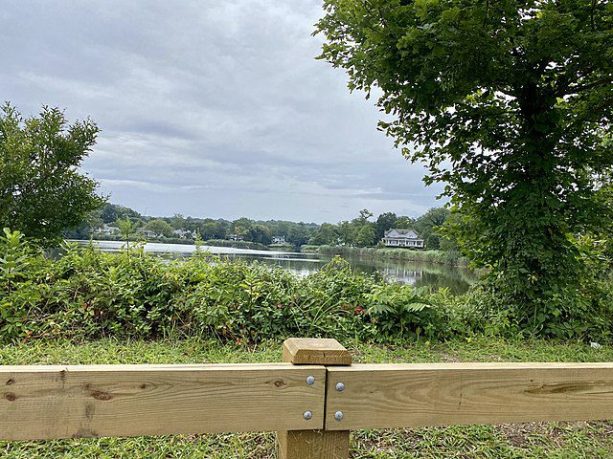Residents who advocated against a Plandome Manor homeowner’s backyard proposal that would potentially threaten nearby Leeds Pond said their fight to protect the natural space was not ending despite its approval. That promise has stayed true as residents utilize various methods to continue fighting the Zoning Board’s permission and mitigate its environmental effects.
“Unless there is some government entity or municipality that just kind of puts their foot down and says ‘no, you can’t do this because of the cumulative harmful effect on the pond,’ then the pond is going to continue to be degraded and end up being dead water,” said Christopher Murray, an attorney representing the residents opposing the project. “I think that will be terrible.”
In July, the Village of Plandome Manor’s Zoning Board approved a resident’s proposal to place 350 cubic yards of site fill in the backyard, which opponents contend would have negative environmental impacts on the nearby Leeds Pond.
On March 5, the Plandome Manor Board of Trustees discussed an appeal to the Design Review Board’s decision to greenlight the application.
Murray said he was encouraged after the March 5 meeting because it felt like the trustees were listening to his coalition’s concerns.
He said the Board of Trustees reserved its decision on the Design Board appeal and is uncertain about when a decision will be delivered.
Leeds Pond, part of Nassau County’s 35-acre Leeds Pond Preserve, overlooks Manhasset Bay and covers approximately 21.4 acres with a tributary watershed area of around 2.275 acres.
The homeowners, New York Islanders center Bowie Horvat and his wife Holly Horvat, originally proposed 500 cubic yards of fill to be placed in their backyard, but the zoning board lowered the amount in an alternative proposal to 350 cubic yards. Village code allows up to 50 cubic yards of site fill, which is the use of soil, sand or other building materials to change the existing ground level of an area of land according to the code.
The homeowners’ attorney said the reason for the dirt fill is so that their two kids can play in the backyard.
A resident coalition called Save Leeds Pond was formed in response to the proposal. The group advocated against the proposal and fought to have it disapproved due to the environmental impact it would have on the neighboring pond.
The coalition and concerned residents have filed various lawsuits challenging the proposal, as well as supporting an appeal of the village’s Design Board approval.
“A common thread is the concern about Leeds Pond,” Murray said.
A lawsuit challenging the Zoning Board’s decision to grant the applicant approval for the dirt fill, otherwise known as an Article 78, was filed in Nassau County Supreme Court in August. The suit was filed by Murray on behalf of the concerned residents.
The lawsuit is against both the village’s Zoning Board as well as the Horvats.
Depending on the outcome of the Article 78 lawsuit, Murray said, the Horvats could be asked to return their property to its prior condition. He said he believes the fill by the Horvats has already been completed.
In tandem with the lawsuit against the village is also a private right of action lawsuit filed against the Horvats by the group of residents in opposition to the fill. Murray said this lawsuit alleges adverse possession and nuisance due to the water runoff into the pond and surrounding properties.
“The well-being of the pond has been degraded and will continue to be degraded,” Murray said.
The lawsuits are still pending as they continue to be heard in court.
The main concern of Save Leeds Pond members and residents participating in the challenge is the well-being of the pond, Murray said, which is the driving force for their actions.
Murray said the fill is harmful to the pond through run-off that occurs due to rain, which then deposits harmful chemicals into Leeds Pond such as the nitrogen present in dirt fill.
He said an environmental expert previously told the zoning board that the implementation of the dirt fill is equivalent to 30 septic tanks being introduced to the area in terms of the levels of nitrogen it deposits.
The introduction of nitrogen in the pond depletes its oxygen, kills the fish and causes algae bloom, Murray said.
Plandome Manor Mayor Barbara Donno has stressed that the project has full approval from the state’s Department of Environmental Conservation, which is the authoritative body on wetlands like Leeds Pond.
“All necessary precautions and measures have been taken to adhere to the guidelines and regulations set forth by the DEC, ensuring the environmental sustainability and integrity of the area,” Donno wrote in a letter posted to the village website.

